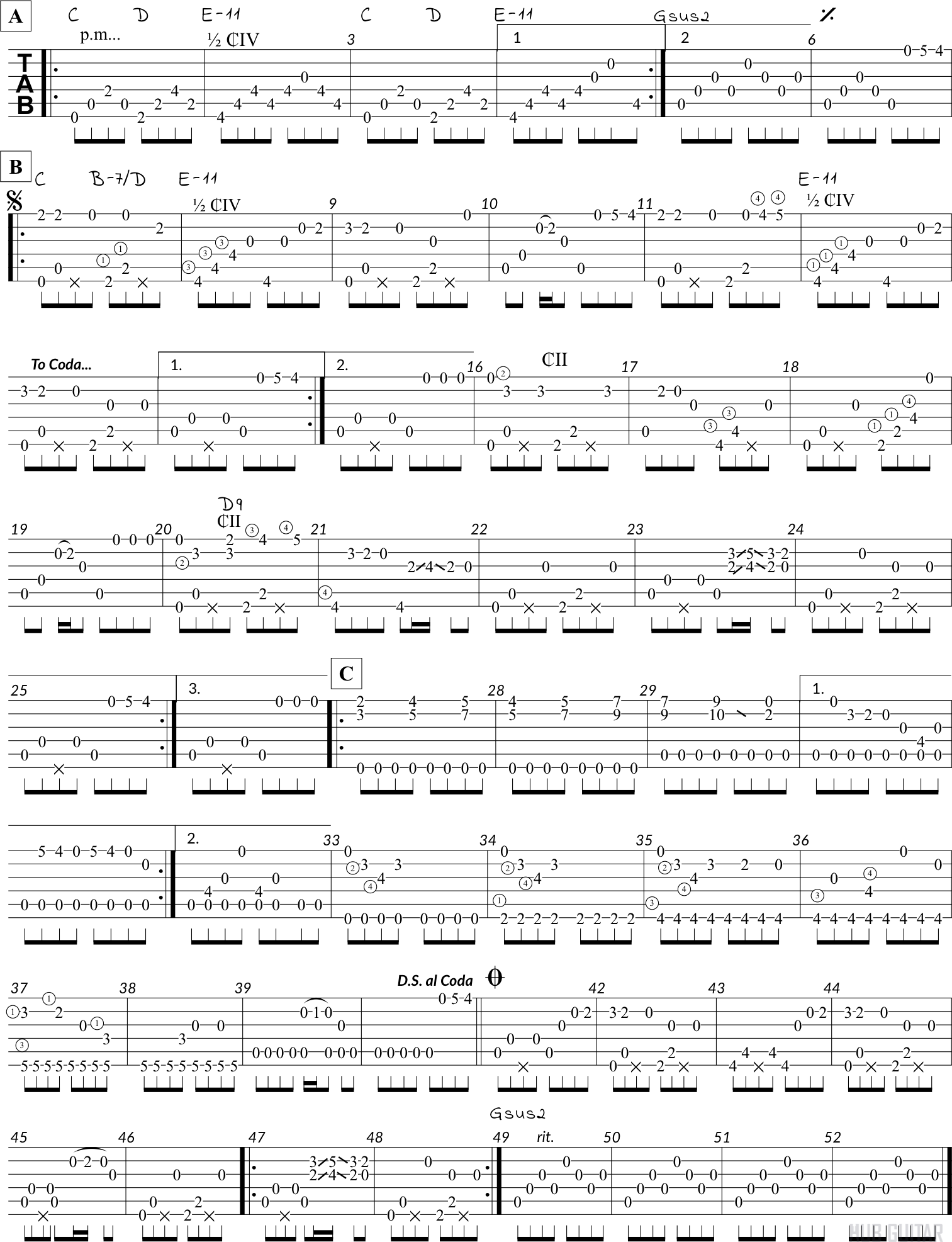Time Travel (Masaaki Kishibe)
Time Travel introduces the idea of adding a percussive slap on the backbeatThe backbeat in popular music normally refers to beats 2 and 4, where ordinarily a snare drum or similar punchy percussion will outline these beats. It is a staple of much of contemporary popular music.. This percussive slap appears on beats 2 & 4, but only when there are no other notes to play, making it an easy way to begin learning the technique. A more advanced version is to create a percussive slap on beats 2 & 4 no matter what, but this is somewhat more challenging.
The Percussive Slap Technique
Practice the percussive slap by striking the strings or body of the guitar. Note that you can accomplish this in a myriad of ways, but most players slap the strings. While you can slap all of them, striking the 6th string with the thumb is quite enough, in fact this one string produces most of the sound from a string slap.
The Form
- Play A, first ending: mm1-3 and take first ending at m4
- Play A, second ending: mm1-3 and take second ending at mm5-6. Continue to Section B.
- Play B, first ending. Take mm7-13 and take the first ending to m14. Return to the beginning of B (m7).
- Play B, second ending: Play mm7-13 and take the second ending to m15. Continue to m25 before returning back to the beginning of B.
- Play B, third ending: Play mm7-13 and jump to the third ending at m26. Continue on to C.
- Play C, first ending: mm27-31. Return back to the beginning of C.
- Play C, second ending: mm27-29, then jump to second ending at m32. Play through until the D.S. al Coda at m40. This tells us to jump back to the Del Segno at B (m7)
- Play C, then jump to coda: play mm7-13, then jump to the coda at m41.
- Play from 41 to the end. Note that 47-48 can be repeated a few times if you like.
Objectives
- Practice the two primary chord shapes, 224000 and 444000.
- Slowly practice the percussive slap on beats 2 & 4.
- Take care to practice the double-slide on m23. Practice this around 100 times.
- Section C should be practiced very, very slowly; fortunately, the actual rhythm is completely even, so if you practice very slowly and play each note with the same steady rhythm (as a metronome might), you will eventually master it and hear the counter-rhythm of the melody.
- Learn how to tune your guitar to open D tuning (CGDGad).
- Practice the tune slowly.
Tuning
CGDGad; capo III
Melody/Lead Sheet
Click here to download the pdf.

About the Artist
Masaaki Kishibe of Osaka, Japan is one of the finest and most widely-regarded fingerstyle guitar players in Asia. He tours with a wide variety of artists. A younger Andy McKee toured with him before. An alumnus of Berklee College of Music, Masaaki Kishibe's music is notable in that it is not excessively complex, allowing listeners of all types to enjoy. It is perhaps because of this that many of Masaaki Kishibe's tunes end up being possible for even beginners to play.
Copyright
Copyright for this composition and its notation belongs to Masaaki Kishibe. Used with permission; please do not duplicate. We respect copyright, so if you have any concerns at all, please contact us.
 As the creator of Hub Guitar, Grey has compiled hundreds of guitar lessons, written several books, and filmed hundreds of video lessons. He teaches private lessons in his Boston studio, as well as via video chat through TakeLessons.
As the creator of Hub Guitar, Grey has compiled hundreds of guitar lessons, written several books, and filmed hundreds of video lessons. He teaches private lessons in his Boston studio, as well as via video chat through TakeLessons.